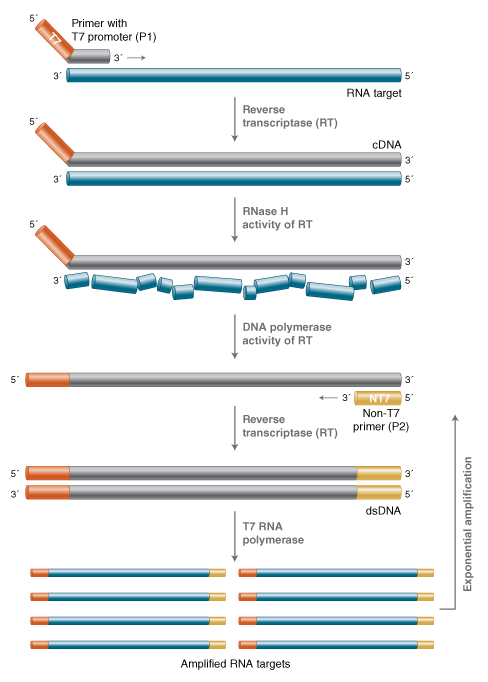
Streptococci
 A large group of Gram-positive cocci distributed widely in men and animals, mostly forming part of normal flora, but some species responsible for some major infections. Individual cells 0.5 -1 µm in diameter and because they divide in one plane only, occur in pairs and chains. The medically significant streptococci may be conveniently divided on the basis of either hemolysin on blood agar (complete hemolysins – beta, partial hemolysins – alpha. No hemolysins – gamma) or by the presence or absence of a group specific carbohydrate antigen (i.e. Lancefield).
A large group of Gram-positive cocci distributed widely in men and animals, mostly forming part of normal flora, but some species responsible for some major infections. Individual cells 0.5 -1 µm in diameter and because they divide in one plane only, occur in pairs and chains. The medically significant streptococci may be conveniently divided on the basis of either hemolysin on blood agar (complete hemolysins – beta, partial hemolysins – alpha. No hemolysins – gamma) or by the presence or absence of a group specific carbohydrate antigen (i.e. Lancefield).
Streptococcus pyogenes:
Characteristics: Gram-positive cocci in chains, cells less then 1µm diameter, non-motile, non-sporing.
Transmission: Normal habitat is the human upper respiratory tract and skin. Spread by airborne droplets and by contact. Survival in dust may be important.
Epidemiological typing of strains based on M and T proteins useful in outbreaks.
Diseases
- Infection of upper respiratory tract
- Skin and soft tissue (pharyngitis, cellulitis, erysipelas, lymphadenitis).
- Toxic manifestation includes scarlet fever.
- Non-suppurative sequelae: Acute glomerulonephritis and Rheumatic fever
- Pyogenic infection
Laboratory Diagnosis:
Sample collection: Throat swab, pus or blood
Methods for identification of organism:
Streptococcus species are non-motile, non-sporing coccus.
Direct methods:
1. Gram staining : Gram-positive cocci, cells often in pairs and chains
2. Culture:
⇒ Culture media: Blood agar
⇒ Grow well aerobically and anaerobically
⇒ β haemolysis and Bacitracin sensitive
3. Antibiotic sensitivity test
Indirect methods:
1. A.S.O. titer (Anti streptolysin O titer): It is important in the investigation of post streptococcal diseases. Titer more than 200 IU/ml is significant
2. Estimation of DNAas B antibody: used for diagnosis of post streptococcal Acute glomerulonephritis and Rheumatic fever. Titer more than 300 IU/ml is significant.
Streptococcus pneumoniae
Characteristics: Gram-positive coccus characteristically appearing in pairs in Gram films. Cells approximately 1 µm in size, often capsulate. Requires blood or serum for growth. Capable of aerobic and anaerobic respiration; growth may be enhanced in CO2.
Diseases: Pneumonia (Capsular type III frequently associated with pneumonia), Septicemia, Meningitis, Bacteraemia, Endocarditis, paricarditi, Otitis and related infection in children.
Transmission: Normal habitat is the human respiratory tract; up to 4 % of population may carry in small numbers. Transmission via droplet spread.
Laboratory Diagnosis:
Sample collection:
1. Sputum for microscopy and culture.
2. Blood for culture
3. C.S.F. for microscopy, culture and biochemistry
Methods for identification of orgainism: non-motile, non-sporing coccus.
Direct methods :
1. Gram staining : Gram-positive cocci, diplococcus, capsulated
2. Culture:
⇒ Culture media: Chocolate agar, blood agar
⇒ Grow well in carbon dioxide enriched media,
⇒ α haemolysis, draughtsman colonies that may autolyse within 48 h at 350
- Biochemical Reactions :
- Catalase negative.
- Susceptible to bile and optochin.
- Polysaccharide capsule can be demonstrated by appropriate staining techniques. They are antigenic and in the presence of specific antiserum appear to swell (quellung reaction).
- Antibiotic sensitivity test
Enterococcus:
Formerly classified in the genus Streptococcus with which they share many characteristics; there are currently 15 species of which two, E. faecalis and E. faecium are of medical importance and are considered together.
Characteristics: Gram-positive cocci, cells often in pairs and chains; more ovate-appearance than streptococci. Non-fastidious; capable of aerobic and anaerobic respiration.
Diseases: Urinary tract infection and wound infection.
Laboratory Diagnosis:
Sample collection:
⇒ Throat swab, pus or blood for isolation of S. pyogens
⇒ High vaginal swab, blood, CSF., ear swab for isolation of S. agalactiae
⇒ Urine or pus to isolate enterococci
⇒ Blood for A.S.O. titer
Methods for identification of organism:
Streptococcus species are non-motile, non-sporing coccus.
Direct methods:
1. Gram staining : Gram-positive cocci, cells often in pairs and chains
2. Culture:
⇒ Culture media: Blood agar
⇒ Grow well aerobically and anaerobocally,
⇒ β or no haemolysis
⇒ Bile aesculin test positive
⇒ Litmus milk reduction test positive
⇒ Heat tolerant, Salt tolerant and Bile tolerant
3. Antibiotic sensitivity test
Viridans Streptococci:
There are several species of alpha-hemolytic streptococci. Most species are commensals in the mouth. S. mutans is strongly associated with dental carries. Several species are capable of causing bacterial endocarditis.






